The Ultimate German Volume Training Plan To Get Big Muscles Fast
Follow this four-week, three-workouts a week plan to bulk up your arms, chest, shoulders, back and legs
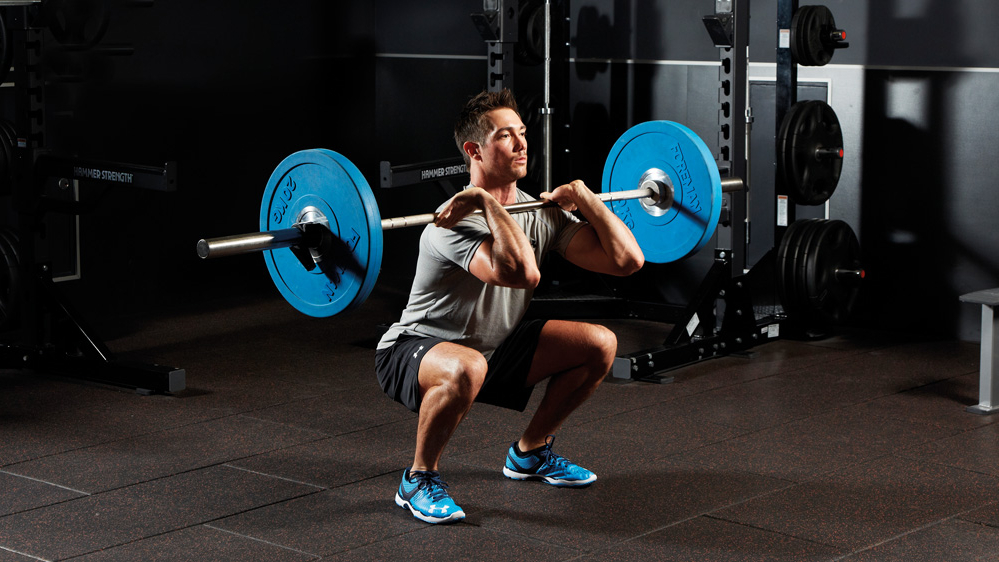
There aren’t many things that old school body builders and modern sports scientists agree on but one of them is that volume is a key variable in the quest for muscle growth. In training terms, volume refers to the total weight lifted during a session. If you want to increase your volume, the most sensible way to do it is to increase the number of sets you perform. If you tried to do it by increasing the weight you lift you’d hardly be able to do any reps, and if you did it by doing high-rep sets then you’d take yourself out of hypertrophy rep ranges.
Renowned strength coach Charles Poliquin was well aware of this when he created his German Volume Training (GVT) protocol, which essentially involves doing ten sets of ten reps of an exercise. If you select the right weight – which will take a bit of experimentation – you shouldn’t be able to complete the tenth rep of the tenth set. Ideally you should start to fail two or three sets out from the finish, but you should still continue and do as many reps as you can in the final set.
How it works
This four-week plan is made up of three workouts. In the first you work your chest and back so that you can challenge one target muscle group while the other recovers, doing the first two moves as a superset to make it as testing and efficient as possible. You only do two GVT moves because it is such a demanding way to train. The final two exercises hit the same muscle groups to enable you to reach total fatigue with only three sets.
The second workout follows a similar pattern but works the front and back of your thighs. The final session involves doing a shoulder move as a simple set, then a biceps and triceps superset with an abs move to finish.
Follow the sets, reps and rest instructions for each move to get the maximum benefit. Do each workout once a week for four weeks, aiming to increase the amount you lift each week – and make sure you note how much you lift in each session to track your progress and keep yourself motivated.
How to warm up
Doing ten sets of ten reps is a pretty hardcore way to train, so you need to put your body in the best possible place to succeed in these workouts with a comprehensive warm-up. This gym warm-up routine starts with a series of dynamic stretches that prime the whole body, but just as important is the second section in which you work on some exercise-specific warm-ups.
This means exercises that focus on the same muscles you’re about to target with your workout. Owing to the high amount of sets and reps involved in German volume training, you won’t be doing a lot of different exercises in any given workout, so you have time to prepare for each of them directly within a five- to ten-minute warm-up. The easiest way to achieve this is to do a set or two of each exercise using very light weights, warming up the key muscles used. This will let you nail your first set proper when the time comes, as well as reducing your risk of injury.
Get the Coach Newsletter
Sign up for workout ideas, training advice, reviews of the latest gear and more.
Workout 1: Chest And Back
1A Incline bench press
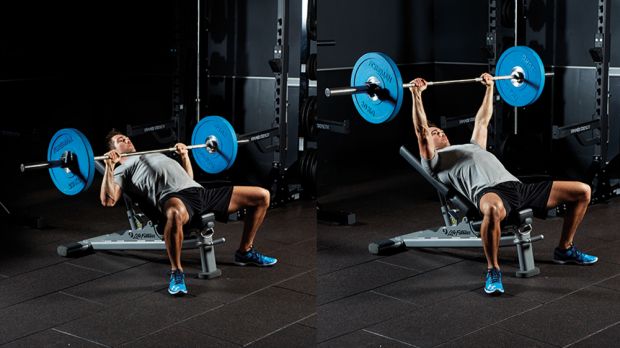
Sets 10 Reps 10 Rest 10sec
Why The incline version of the move puts a slightly different emphasis on your muscles, working the front shoulders a bit more than the flat version does. You’ll probably find you can’t lift quite as much weight because of this.
How Lie on a bench set at a 45˚ incline, holding a bar over your chest with your hands just wider than shoulder-width apart. Lower the bar until it’s touching your chest, then press it back up.
1B Bent-over row
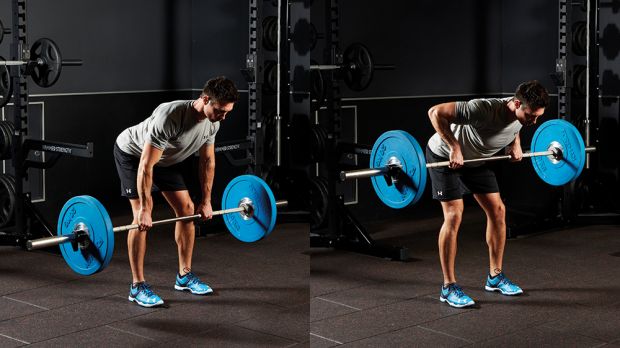
Sets 10 Reps 10 Rest 90sec-2min
Why This move works the opposing muscles to the incline bench press. Having a strong back improves your posture, which will allow you to lift heavy weights safely and also reduce your chances of injury.
How Hold the bar with a shoulder-width grip, bending your knees slightly. Bend at the hips until your torso is at roughly a 45˚ angle to the floor. Pull the bar up to touch your sternum and then lower under control. If you’re moving your upper body to shift the bar, the weight’s too heavy.
2A Incline dumbbell press
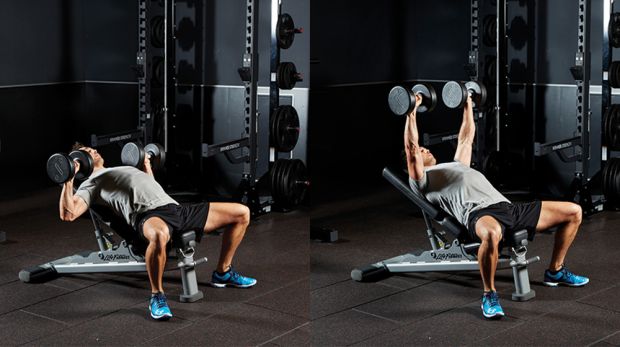
Sets 3 Reps 6-8 Rest 10sec
Why This is similar to the barbell version but it allows you to squeeze a bit more work out of your muscles safely once you have completed the previous exercise. It will also challenge the stabilising muscles around the shoulder joint.
How Lie on a bench set at a 45˚ incline, holding a dumbbell in each hand with your arms straight up. Lower the weights to chest height, keeping your elbows close to your sides, then press back up to the start.
2B Single-arm row
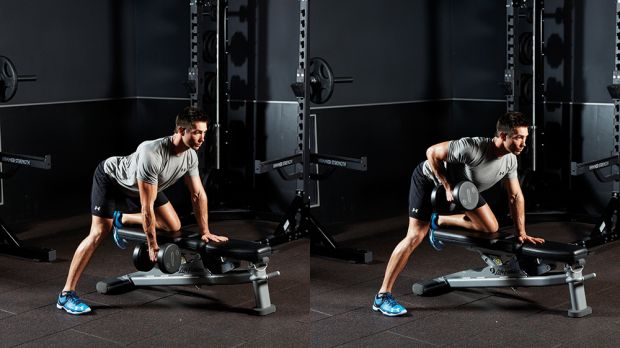
Sets 3 Reps 6-8 each side Rest 60sec
Why This isolation move works one side of your body at a time, and allows you to shift more weight.
How Set up with one knee resting on a bench and the other foot on the floor, leaning forwards slightly and holding a dumbbell in one hand. Row the dumbbell up until your thumb touches your armpit, then lower back to the start. Complete all the reps on one side, then switch.
Workout 2: Legs
1A Front squat
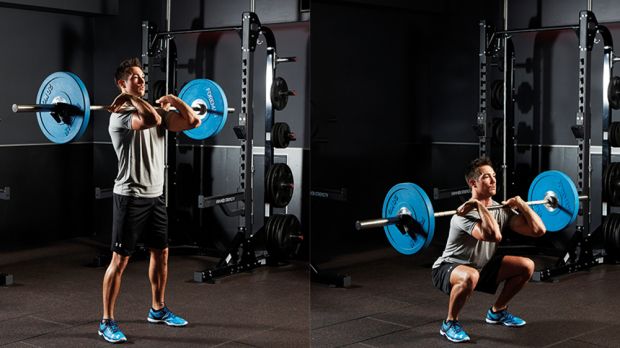
Sets 10 Reps 10 Rest 10sec
Why The aim of this superset is to work both the front and back of your thighs. Placing the bar on the front of your shoulders puts the emphasis on your quads and also makes the move safer – you’ll be less likely to tip forwards and endanger your lower back.
How Take the bar out of the rack so it’s resting on the front of your shoulders and hold it in place with your palms facing upwards. Squat down, keeping your chest up, then drive up through your heels to stand.
1B Romanian deadlift
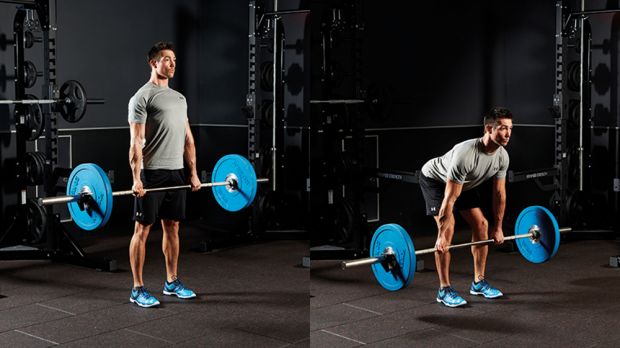
Sets 10 Reps 10 Rest 90sec-2min
Why This develops your glutes and hamstrings, areas that most men would benefit from strengthening. The movement, essentially a hip hinge, has a huge positive carry-over to everyday activity.
How Stand tall with your feet shoulder-width apart, holding a barbell with an overhand grip just outside your thighs. With a slight bend in your knees, bend forwards from the hips and lower the bar down the front of your shins until you feel a good stretch in your hamstrings. Push your hips forwards to reverse the move to the start.
2A Bulgarian split squat
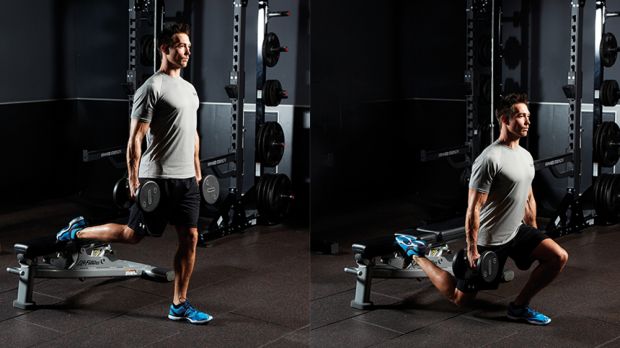
Sets 3 Reps 6-8 each side Rest 60-90sec
Why This variation of the squat will target your quads – a key muscle group involved in heavy squats. It also works your legs independently so that you are equally strong and stable on both sides.
How Start with your back foot on a bench and your front foot approximately 60cm in front of the bench, holding a dumbbell in each hand. Bend at the knee to lower towards the floor, keeping your torso upright, then press back up to the start. Make sure that your knee is in line with your ankle and that your front foot is far enough forwards that your knee doesn’t travel in front of your mid-foot. Complete all the reps on one side, then switch.
2B Kettlebell swing
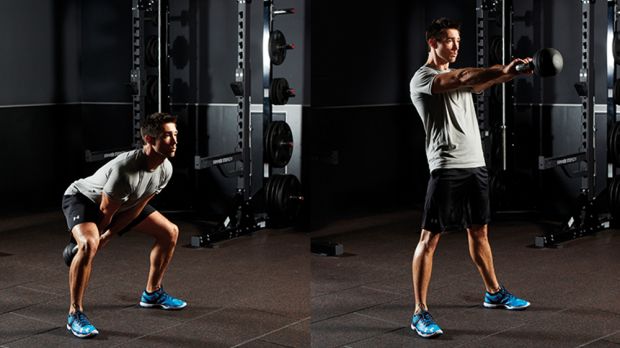
Sets 3 Reps 10 Rest 60-90sec
Why This move engages all the muscles of your posterior chain, but also teaches the explosiveness you need to do everything from throwing a punch to jumping onto a box. Remember, it’s a swing and not a squat: you only need to bend your knees as much as you would before a big jump.
How Swing the kettlebell between your legs with both hands, and then pop your hips forwards to drive it up to head height, keeping your arms relaxed. Let the kettlebell swing back into the next rep – again, you don’t need to bend your knees much.
See related
- 5x5 Workout: The Texas Method
- The Tried-And-Tested Muscle-Building Workout
- 51 Ways To Build Muscle Faster
- How To Build Muscle Naturally
Workout 3: Shoulders And Arms
1 Overhead press
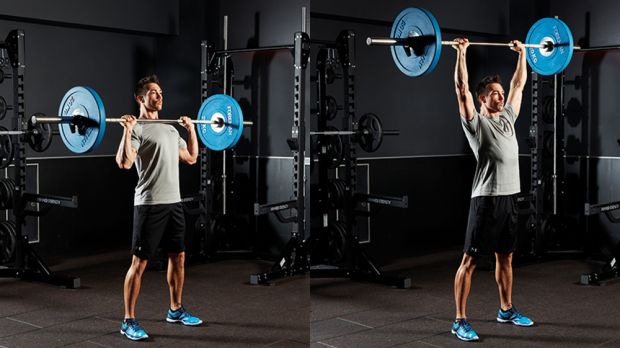
Sets 10 Reps 10 Rest 90sec
Why As well as working your entire shoulder joint, lifting a heavy weight overhead will also improve your core and abdominal strength because those muscles need to be switched on to stabilise your spine.
How With your feet shoulder-width apart, hold a bar on your upper chest, hands just wider than shoulder-width apart. Brace your abs, glutes and quads as you press the bar straight upwards. Pause at the top, then lower. You may find wrapping your thumbs around the same side as your fingers allows you to lift more weight.
2A Biceps curl
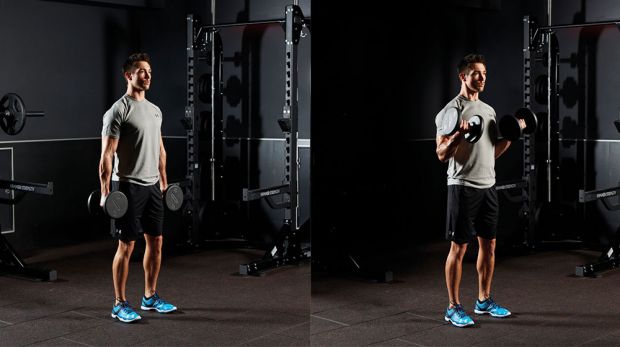
Sets 10 Reps 10 Rest 10sec
Why In this session you do three GVT moves rather than two because the arms exercises will present less of a challenge to your central nervous system, which means you can do more work.
How Stand tall with your shoulders back and your feet close together, holding a pair of dumbbells with palms facing forwards and hands just outside your hips. Keeping your elbows tucked in to your sides, curl the dumbbells up towards your chest, stopping just before your forearms reach vertical. Lower under control to return to the start position.
2B Diamond press-up
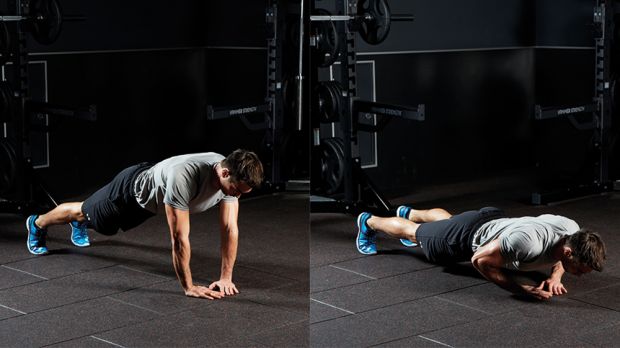
Sets 10 Reps 10 Rest 90sec-2min
Why This is a deceptively tough exercise. Moving your hands close together to form a diamond shape will put a lot more emphasis on your triceps. Don’t be surprised if you struggle to hit the rep count if you’re new to this exercise – just focus on maintaining good form.
How Get into a press-up position, placing your hands close together so your thumbs and index fingers touch. Keeping your body in a straight line with your abs braced, lower your torso until your chest is just above the floor, then press back up.
3 Plank
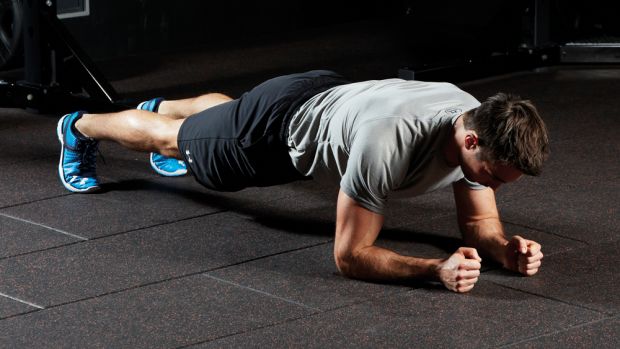
Sets 3 Time 30-40sec Rest 60sec
Why The plank will help to build core stability, which is useful for every aspect of fitness and complements the GVT work you’ve done earlier in the session.
How Get into position with your body in a straight line from head to heels and your elbows directly below your shoulders. If your hips are too high that will take tension off the core muscles; if they are too low it will put strain on your lower back.
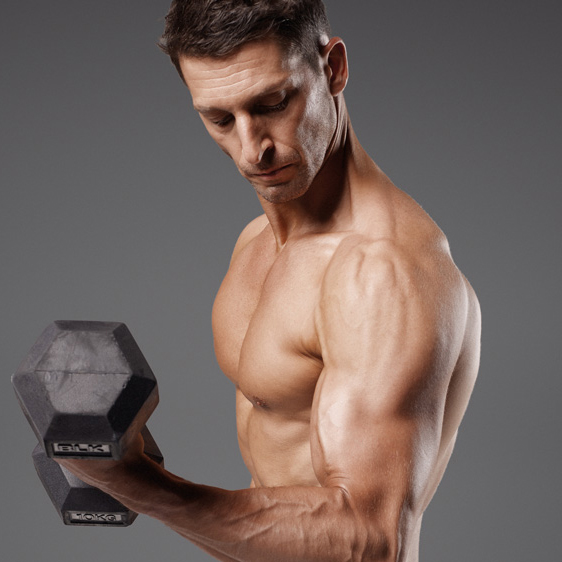
Joe Warner is a highly experienced journalist and editor who began working in fitness media in 2008. He has featured on the cover of Men’s Fitness UK twice and has co-authored Amazon best-sellers including 12-Week Body Plan. He was the editor of Men’s Fitness UK magazine between 2016 and 2019, when that title shared a website with Coach.









